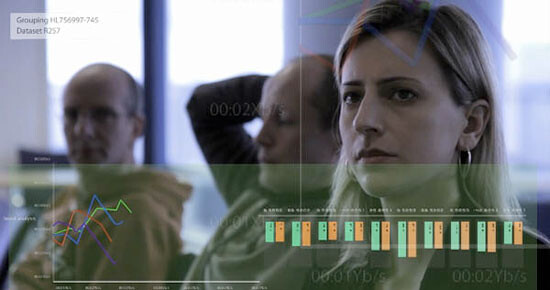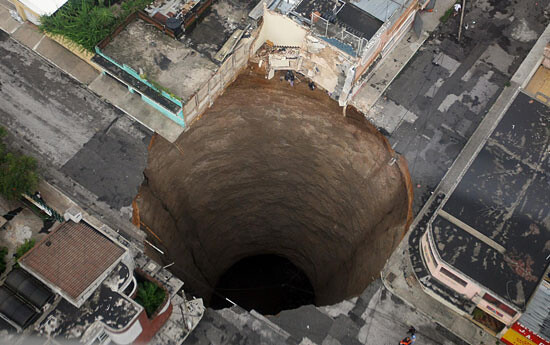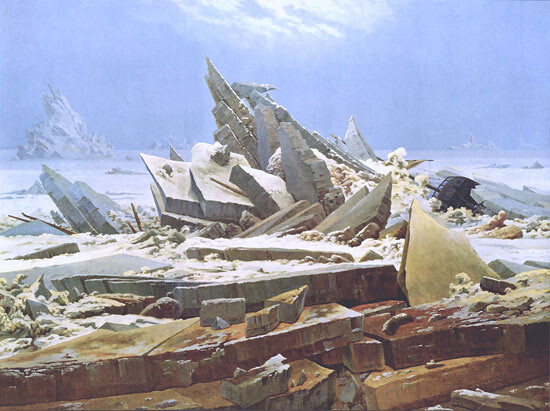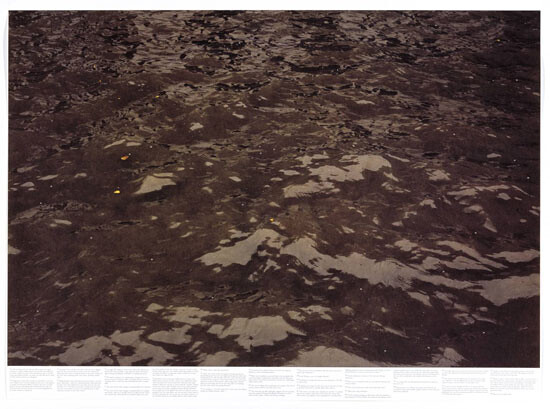Weather is the key paradox of our time. Weather that is nice is often weather that is wrong. The nice is occurring in the immediate and individual, and the wrong is occurring systemwide.
—Roni Horn in 20071
The sublime of the nineteenth century was described by Kant as the feeling of watching an avalanche from a distance. A glacier crumbles, a frozen world breaks down, creating awe and shock and awe again, pleasure and horror at the same time—but always at a remove. Today the sublime of the nineteenth century has gone haywire. It’s more like a monster wave. A tsunami as freeze frame. A twister exhaling in slow motion, collapsing a block of South Asian textile factories. A moment of exhilarated foam suspended high up then crashing down to devastate your lives terminally. The razor-sharp spike of an algorithm when it crests, just barely high enough to brush up against the inside of the bubble.
The distance between the observer and the disaster has disappeared. In fact the observer and the disaster might even be the same thing. It’s as if when one bubble bursts, another one expands to become the atmosphere itself. We are standing above the remains and the rubble of the first, but still inside another enclosure that arrives as some sort of psychotic causality. Is there a way out of the market or are we only trapped inside with no escape? Yes and yes! The trouble has to do with being liberated and newly imprisoned in such quick succession. You are watching the storm and being blown and carried away by it at the same time. This is why you may often feel that you’re in competition with yourself, or that you are not yourself at all. You may be a wanderer above the mist, but you are also in the mist.2 The Caspar David Friedrich painting went gray. You think you may be God himself, but you still need Google Maps to find your way through the mist. The wanderer lost his phone and is just trying to get to a restaurant.


In the aftermath of the financial crisis, Wall Street firms made some very interesting adjustments. It is well known that after slashing jobs by the thousands, salaries and bonuses for individual executives reached record highs. But how is this possible? Did executives simply stuff their own pockets with bailout money? Well, yes, but only through a much larger systemic adjustment by which Wall Street firms essentially diverted money away from infrastructure and support staff, clearing the way for a slimmer workforce of highly gifted, self-sufficient, and well-paid geniuses.
This allowed the liquidated infrastructure to flow into the hands of individuals whose extraordinary intelligence and instinct could singlehandedly sustain the entire system. And of course, without infrastructure these highly gifted geniuses would find themselves in a strange vacuum—with no desk and chair, no heating, probably no office to go to for work, and possibly looking to rent a warehouse space next to an artist studio in Brooklyn, where even a sizable private staff could be hired out of a single salary to sustain a semiautonomous fiefdom. Following the liquidation of institutions private and public alike, not only the creative industries but now also the financial executive starts to inhabit a condition traditionally associated with the artist.
Around the same time as the crash, while artists and art institutions feared the worst, many have been surprised to find the field of art as a whole thriving, even in spite of savage cuts to public funding nearly everywhere. Institutionalized austerity seems to remake the artist into a carrier of a much more important technology—one that it becomes increasingly necessary to understand and access. And the sensitive artist still guilty from being an agent of property speculation and gentrification during the boom years of the creative class may not have seen the ruins of that cutesy economy in cities like Dublin.3 As a vanguard of resilience in the face of impoverishment, the artist who beautified low-income or derelict neighborhoods has only more to give, because he or she is also an originator of extra-economic technologies, of ways of living inside and outside of economic relations, of the conquering genius of exemplary survival, with some misshapen idealism that pours forth seemingly endlessly, with or without resources, over and above demands and expectations.
Either due to an increasingly abstracted political conviction, or some metaphysical contact with eternity within the studio, the artist always dreams of going beyond. But what happens when that is actually possible? Just look at Bradley Cooper’s character in Limitless (2011), who found a pill to give him unlimited mental power. The character who began as a tortured writer quickly dropped fiction for finance, before finally going into politics—only at the end. It is a portrait of the hero of instability—a pill-popping super genius who can get the fast read on all the angles of any situation ad infinitum.
Let’s consider for a moment that these superpowers are actually real. It’s important to point out that this genius figure is not simply a decoy but is actually fully operative, because we know artists are both inside and outside of economic exploitation. It’s not just some fiction (or pill). An artist actually does exceed the terms of the economy. Look at the artist who watches his or her civilization collapse due to revolution, civil war, or economic disaster, only to withdraw into feverish art production. The deft, outmaneuvering cosmopolitan from the broken society who was raised on other societies or false histories, and whose life was basically already art from a very young age, comes out the other side through proposals that manifest in their work. This artist becomes the model of disaster survival.
An infrastructure is being built around this model. Liquidated finance office furniture takes shape again to make the rods of pop-up art fair tents. The young cosmopolitan gets pushed into a weird speculative statecraft. Just as an overpaid financial weather prophet has to sustain the whole system, the forward-looking artist has to produce entire worlds within, and in spite of, the wobbly art fair tent. Artworks start to assume a new concreteness—on the one hand strangely stabilizing to replace real estate as objects of financial speculation, and on the other projecting a kind of clarity, even ideological, even critical and external, that can go beyond the horizon of an economic day that never ends.
But even the financial value of artworks is not based in individual works, but in the career of the artist, in the rising trajectory of her person in time.4 The artist thus assumes a double responsibility to outperform himself constantly, to grow and evolve in spite of austerity and stagnation everywhere else. It is a strange and contradictory double role of serving and evading demands simultaneously, which means creating works and technologies that constantly reinvent ways of exceeding their own structural limits in time, in space, in political prospects. It’s a structural drive to become a sorcerer producing a kind of magical alchemy of the outside from within.
In traditional economic terms, these demands for surplus are characterized as exploitation, or artistic self-exploitation. But artists are flexible by nature, and a traditional view of quantifiable labor output no longer accounts for what is actually being produced, and it also doesn’t account for what is happening to the producer, as a person, in the process. As the contradictions twist tighter and tighter, it starts to become clear that a massive reallocation of resources from infrastructure to intellect produces a bubble economy within the artist’s person as its primary carrier.5 This means that, as this person develops strange superpowers just to find expansive solutions for constant contractions in time and space, an internalized instability emerges as pure psychosis.


On the one hand, this psychosis produces its own form of vision. But it’s not just that. Haven’t you noticed how the past few years have been distinguished by psychotic weather patterns? Just look at this weather report from earlier this month, about a bizarre snake-shaped weather pattern moving across the United States, bringing snowfall and wildfires:
A highly unusual jet stream pattern is bringing a bizarre combination of heavy May snows, flooding, extreme fire danger, and well below average severe thunderstorm activity to the U.S. A strong “blocking” high pressure system has set up over Greenland, blocking the normal west-to-east progression of weather systems. A truly unusual situation has developed where the blocking high has forced a low-pressure system near Greenland to move southwestwards to a point just off the New England coast. The blocking high has also forced an unusually sharp southwards dip in the jet stream over the Central U.S., where all-time May snowfall and cold temperature records are being set. This loop in the jet stream will get cut off from the main flow of the jet over the weekend, forming a “cutoff” low that will drift over the Southeast U.S., bringing cold, flooding rains of 2–4” over a wide swath of the Southeast. But over the Western U.S., an unusually sharp ridge of high pressure has set up, bringing record high temperatures, a strong Santa Ana wind event, and dangerous fire weather.6
Now weather emerges as a strange figure of a kind of metaphysical instability. It’s as if the market collapse and the dismantling of the fortress of the state as absolute shelter has amplified a sense of vulnerability to the elements to a point where the earth’s atmosphere responded in kind. We all know about climate change, and of course there are clear links between atmospheric events and crop yields that exert pressure on governments and economies. But the effect of weather on agriculture doesn’t explain the degree to which a completely abstract collective emotion has emerged in the past few years to determine the ups and downs of markets and the legitimacy of regimes. The weather arrives first as a metaphor of the atmospheric abstract, then as a figure of volatility after the breakdown of markets and uprisings, and finally as a projection of psychosis and enclosure as a massive, faceless body you cannot exit. The weather assumes the shape of a kind of romantic poetry turned frighteningly concrete. Your feelings control the weather because on the one hand you are insane, and on the other hand because they actually do. Weather as emotion feedback can be lethal. You need to be very careful what you feel. The Wall Street trader who started to lose his mind after the crash looked up into the sky and saw oceans of infographics telling him about markets and futures. The exemplary survivors, the heroes of stagnation, artists, you, me, however—we all have to do the exact same thing to survive.
In 2004, Paolo Virno described the sublime as a paradoxical mix of safety and helplessness when faced with circumstances beyond one’s control:
According to Kant, when I observe a terrifying snowslide while I myself am in safety, I am filled with a pleasing sense of security mixed together, however, with the heightened perception of my own helplessness. Sublime is precisely the word for this twofold feeling which is partially contradictory. With my starting point being the empirical protection which I have benefited from by chance, I am made to ask myself what it is that could guarantee an absolute and systematic protection for my existence. That is to say, I ask myself what it is that might keep me safe, not from one given danger or another, but from the risk inherent in my very being in this world. Where is it that one can find unconditional refuge?
Kant answers: in the moral “I,” since it is precisely there that one finds something of the non-contingent, or of the realm above the mundane. The transcendent moral law protects my person in an absolute way, since it places the value which is due to it above finite existence and its numerous dangers. The feeling of the sublime (or at least one of its incarnations) consists of taking the relief I feel for having enjoyed a fortuitous place of refuge and transforming it into a search for the unconditional security which only the moral “I” can guarantee … There is a sharp bifurcation here: on one hand a particular danger (the snowslide, the malevolent attentions of the Department of the Interior, the loss of one’s job, etc.); on the other hand, there is the absolute danger connected to our very being in this world.7
Judging by its swells and moods, we can infer the ideology of the weather system: paralyzing stasis with intermittent disasters. In the 1993 movie Groundhog Day, Bill Murray is a rude weatherman who finds himself caught in a stagnant loop where he is destined to re-live the same day over and over again in a small town in Pennsylvania. Initially, he discovers an incredible power in being the only one to know what will happen before everyone else, and sets out to exploit all possible opportunities only to have the clock reset yet again for the next day. Eventually, he begins trying to figure out what he is supposed to do in this strange eternity on an earth that revolves endlessly on its axis without ever orbiting the sun. Out of complete boredom, the weatherman is left with only one option: to improve himself and adapt his unruly personality to the looping day in a small town. But what if this small town were the earth? And what if we are the weather forecasters stuck on the wrong side of the End of History in a day that never seems to end?


Let’s be a bit cautious of claims that all this points to a totalizing apocalyptic horror. Many thinkers in recent years have asserted that there is no longer any horizon to speak of, that an old distinction between outside and inside has become null. More recently, the figure of collapsing distinctions has been provocatively resolved in science-fiction terms as pseudo-organic slime or lifelike trash.8 But the figure of inorganic matter animated by capital and trade flows starts to become another sublime taking capital as its object rather than nature. Maybe this can be useful as a figure of confused or lapsed materialism that sees a nineteenth-century idea of nature transported by capital into what Timothy Morton has called “the featureless remainder at either end of the process of production.”9 The danger is that fall-from-grace apocalypse narratives amplify the horror of enclosure, when actually in some dark hidden crevice we are still simply trying to figure out how to be free.
The weather is a warped mirror of this aspiration. It is a doubling confusion between subject and object coming from the psychosis of looking for a way out. The God’s-eye view that forces a resolution of inside with outside in whatever terms is not speculative, but something we inhabit already. Hito Steyerl has pointed out that it is actually through visuality that any ground is produced. It is actually in the act of seeing and monitoring that trembling lines of distinction, scale, and distance are produced through a perspectival sleight of hand:
Many of the aerial views, 3D nose-dives, Google Maps, and surveillance panoramas do not actually portray a stable ground. Instead, they create a supposition that it exists in the first place. Retroactively, this virtual ground creates a perspective of overview and surveillance for a distanced, superior spectator safely floating up in the air. Just as linear perspective established an imaginary stable observer and horizon, so does the perspective from above establish an imaginary floating observer and an imaginary stable ground. This establishes a new visual normality—a new subjectivity safely folded into surveillance technology and screen-based distraction. One might conclude that this is in fact a radicalization—though not an overcoming—of the paradigm of linear perspective.10
This shifts the metaphysics of inside and outside down to the hard infrastructure of surveillance, of who is at the controls and who is subject to being monitored. Our wanderer rising above to contemplate the mist can only be a drone. If you are on the other side, the weather may be your only hope for degraded vision or camera failure.
There is slime in Syria, but it has none of the qualities of the sublime or of science fiction. A friend recently described the dismal state of another country in mid-post-revolution by saying that it was really inspiring when things broke open and all this shit started coming out. But it never stopped! Now there is sewage gushing everywhere and some people start to ask how to put the lid back on, to go back to the way things were, anything. In fact the Syrian slime is made of something else altogether, and it is not surrounded or enclosed by liberal democracy or capital. Let’s be clear: atmospheric mood swings in Syria come from air power, and the slime is made of blood and rubble. The radical contingency of hypercapitalist slime as an all-consuming natural/unnatural bio-commodity is a figure of faceless mushy power, of a postmodern techno-industrial triumph over the modern. When modernity fails to suppress sectarian differences, the postmodern weather is military, militant, or satanic-fundamentalist, the rain is artillery, and the slime is a putrid mix of blood and psychic sewage. This contingency may look into the atmosphere as its horizon, but it also looks death in the face. And our wanderer above the mist becomes a hawkish general or a commander of a brigade.


The artist coming out of this takes by necessity Kant’s stabilizing moral “I” of the non-contingent as a means of survival. The emotional feedback loops of the stock market could even be a reassuring reflection of one’s desires in an environment where electoral democracy is already assumed to be a joke. The burden to outperform is a preexisting condition when the backdrop for what is being produced has no economy for it in the first place. Actually, it’s taken for granted by most artists who are not completely cynical that the economy around art is a remote supplement, however crucial, to something much larger. The purpose of looking to an abstract figure such as the weather is to understand how a widespread mental breakdown that may have common effects can still originate in many different sources. But it nevertheless exacts a severe toll on the artist’s person. Look at a superhero like Storm from X-Men, whose ability to alter the weather comes from none other than a violent claustrophobia from being buried under rubble during the 1956 Suez Crisis in Egypt. Her ability to change the weather constitutes a demand for space to breathe.
This space to breathe is precisely the purpose of the bubble that suspends determined meaning and value in favor of interpretation. We know very well how orthodox Marxists from wealthy capitalist countries like to cast particularly this suspension of value as the highest form of capital. After all, it is. And it’s true that it leaves artworks open to financial speculation and rampant exploitation. However, when it comes to art, a search for absolute value and meaning leads nowhere fast, or rather it leads straight back to the nineteenth-century Romantic foundations of Marxism. It leads also to the sublime of Kant, to an absolute system that would bring empirical protection from the snowslide. It would allow a distanced contemplation of death, catastrophes, or artworks that is purely aesthetic—a kind of dandy schadenfreude we are familiar with.


But in the new sublime we become both wanderer and mist, landscape and traveler, doctor and patient, cause and effect, artist and artwork simultaneously. We become the weather. If this sounds too hysterical and utterly without any ethical horizon, Gianni Vattimo helps us close the circle by outlining how a wobbly condition of instability actually returns to become the basic foundation of the law. He maintains that interpretation sits at the very center of the production of truth, and that it is necessary to maintain if we are to accept that the law has no absolute foundation, but needs some semblance of one nonetheless—contingent or otherwise:
Interpretation is neither the apocalyptic-messianic unveiling of the violence (injustice) implicit in any position of law, nor the consolatory masking of this violence by means of ad hoc fabulations, but a cumulative process of dissolution of the violence arising from the initial unfoundedness of the law. The logic, logicality, and validity (including ethical validity) of this perfect hermeneutic circularity necessarily escape those who live nihilism as unconsumed grief for a Being that ought to be (the foundation) and is not. This hermeneutic circle is a virtuous circle, the only possible virtue.11
We can start to see this hermeneutic circle emerge as a more productive feedback loop, where nihilism is essentially a fiction produced not by instability itself, but by the sudden removal of a perceived foundation. So, we will survive. But there is one final aspect of the weather I’ve overlooked so far. As a figure of rapture, the instability of weather is both a planetary absolute and a shared condition. Maybe currencies should be pegged to weather.12 Regardless, it brings people together, whether for pleasure or for horror. It is a collective mood swing that arrives as disaster and homelessness, but also as a day at the beach. Funnily enough, as a shared condition in the most extreme sense the weather can even be read as a kind of geopoetic revenge of the public sphere. It actually works as an axis of commonality, which is to say that, if we’re all becoming insane, at least we’ll be insane together.
Thanks to Roni Horn for inspiring the title of this essay with her foundational work from the mid-1990s You Are the Weather.
See Dieter Roelstraete’s prescient essay on aesthetics of drift and immersion from 2010 →.
Has Richard Florida? It seems he did notice. Oops—it was a bubble →.
See →.
See the recent writings of Franco “Bifo” Berardi.
See →.
Paulo Virno, Grammar of the Multitude, trans. Isabella Bertoletti, James Cascaito, and Andrea Casson (Los Angeles: Semiotexte, 2004), 31–-2.
See the object-oriented ontologists who try to think the unthinkable.
See →.
Hito Steyerl, “In Free Fall: A Thought Experiment on Vertical Perspective,” e-flux journal 24 (April 2011). See →.
Gianni Vattimo, Nihilism and Emancipation: Ethics, Politics, and Law (New York: Columbia University Press, 2007), 146.
Although with climate change, this would actually be a terrible idea.
Category
Subject
Thanks to Hito Steyerl.
